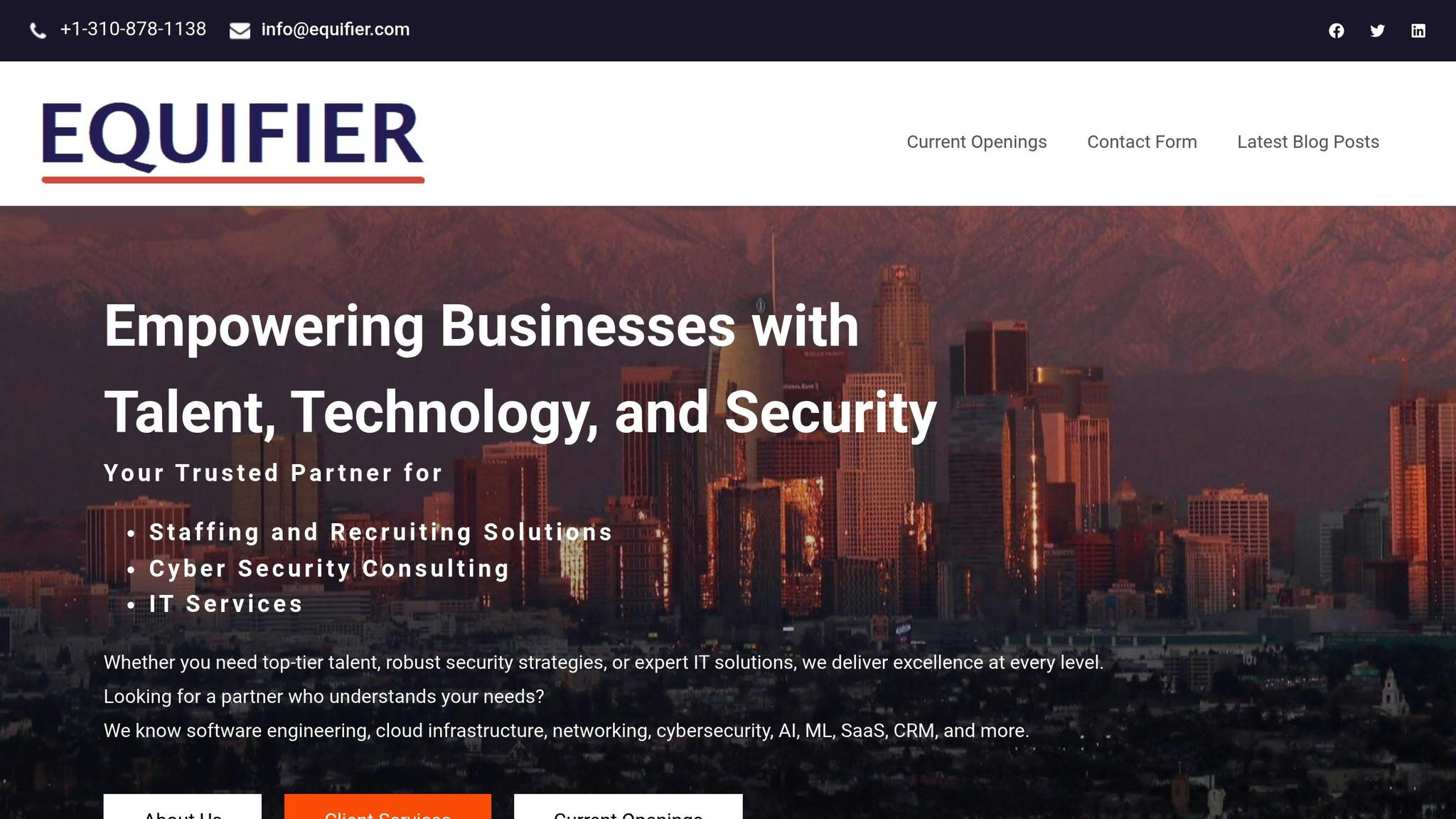- Remote Work is Non-Negotiable: Nearly 90% of tech professionals prioritize remote flexibility. Offer clear remote and hybrid options to attract top talent.
- Speed Matters: Delayed decisions cost you talent. Streamline hiring with tools like AI-powered resume screening and optimized applicant tracking systems (ATS).
- Employer Branding is Key: Showcase your company’s values, growth opportunities, and workplace culture. Use employee stories, video testimonials, and social media to stand out.
- Proactive Sourcing: Reach passive candidates on platforms like GitHub, Stack Overflow, and LinkedIn. Personalize outreach and leverage employee referrals.
- Retention is as Important as Recruitment: Invest in training, career growth, and employee engagement to keep your IT team intact.
- Use Technology Wisely: AI tools and recruitment marketing campaigns can help you target the right talent faster and reduce bias.
- Adapt to Contract and Gig Work: Flexible staffing models are increasingly popular. Offer contract-to-hire options to meet changing demands.
- Partner with Experts: Services like Equifier integrate recruitment, cybersecurity, and IT infrastructure to simplify hiring and retention.
The Bottom Line: IT recruitment in 2025 requires speed, transparency, and a focus on long-term retention. Companies that combine strong branding, advanced tools, and flexible work policies will stay competitive.
2025 hiring success: Key recruitment trends & strategies with Melissa Grabiner
Building a Strong Employer Brand for IT Talent
Your employer brand sets you apart in the competitive race for top IT talent. A well-crafted brand not only attracts candidates who align with your mission but also encourages them to stay for the long haul. To stand out, focus on defining clear values, offering visible growth opportunities, and sharing genuine stories about your workplace.
Displaying Company Values and Culture
IT professionals today are looking for more than just a paycheck – they want to work for companies that reflect their personal values. Salary and benefits matter, but a shared sense of purpose often seals the deal.
Make your company’s mission and values crystal clear across all recruiting platforms. For instance, if innovation is at the heart of your business, highlight it with examples of your cutting-edge technology stack, development practices, and exciting projects. If work–life balance is a priority, back it up with policies like flexible schedules and real-life testimonials from employees.
Your career page should go beyond the usual job descriptions. Bring your company culture to life by detailing your team structure, collaboration tools, and development methodologies. Show potential hires what it’s like to work with you.
Transparency is key. Share not just your successes but also the challenges your team is tackling. For example, if modernizing legacy systems is part of your roadmap, frame it as a growth opportunity rather than hiding it as a drawback.
Don’t underestimate the power of social media in IT recruitment. Encourage your engineering team to showcase their GitHub projects, write technical blogs, or speak at conferences. These contributions not only strengthen your employer brand but also demonstrate the kind of expertise and collaboration new hires can expect.
A strong company culture naturally encourages candidates to imagine a long-term future with your organization, which leads us to the next step.
Promoting Career Growth Opportunities
For IT professionals, career growth isn’t just a bonus – it’s a priority. Candidates want to know they’ll have room to grow and that your company is willing to invest in their development.
Be specific about the training and certifications you support. Cover costs for certifications, workshops, or conferences, and make it clear that professional development is part of your company’s DNA. Mentorship programs are another big draw. Junior developers value guidance from seasoned professionals, while experienced team members often enjoy the chance to mentor others. Highlight these opportunities and share real examples of how employees have benefited.
Stories of internal promotions can make a big impact. For instance, showcase how a junior developer advanced to a team lead role or how a system administrator transitioned into a DevOps position. These examples give candidates a clear picture of what’s possible within your organization.
Not everyone wants to move into management, and that’s okay. Many IT professionals prefer advancing their technical skills. If your company offers senior engineer, principal engineer, or architect-level roles, make sure to emphasize these paths. Showing that you value technical expertise as much as leadership roles can appeal to a wide range of candidates.
By providing clear growth opportunities, you reinforce your employer brand and create space for authentic employee stories.
Using Real Employee Stories
When it comes to attracting IT talent, nothing speaks louder than the voices of your own team. Authentic employee stories provide credibility and help candidates picture themselves as part of your company.
Video testimonials are a great way to highlight team experiences. Feature employees talking about their favorite projects, the tools they use, and how the company has supported their growth. Keep these videos casual and unscripted to ensure they feel genuine.
“Day-in-the-life” content is another effective tool. Show what a typical day looks like for different roles, whether it’s a frontend developer collaborating on a new feature or a database administrator solving complex challenges. This type of content helps candidates evaluate whether your workplace is the right fit for them.
Encourage your team to share their experiences on platforms like LinkedIn. Posts about project milestones, learning moments, or snapshots of company culture often reach a wider audience than corporate accounts, thanks to the personal touch.
Case studies can also highlight your team’s technical accomplishments. Share stories about complex challenges your team has tackled, focusing on the process, tools, and lessons learned – not just the end result. These stories not only showcase your company’s expertise but also demonstrate the growth opportunities awaiting new hires.
Finally, make sure to feature a diverse range of employees. Highlight stories from recent bootcamp graduates, career changers, and seasoned pros alike. This sends a clear message: your company values talent from all backgrounds and experiences, creating an inclusive environment for everyone.
Using Technology to Improve Recruitment
Expanding on the importance of employer branding, incorporating technology into your recruitment process can take things to the next level. A well-chosen tech stack simplifies IT hiring by using data to make the process more efficient. Modern recruiting tools not only help you find the right candidates faster but also minimize unconscious bias and enable smarter hiring decisions. The trick is selecting tools that fit seamlessly into your current workflow while addressing the specific challenges of IT recruitment. This technological approach works hand-in-hand with the strong employer brand we discussed earlier.
Using AI-Powered Tools
AI is transforming IT recruitment by delivering tangible results. These tools excel at tasks like analyzing resumes, identifying key skills, and matching candidates to the right roles.
One of the biggest advantages is how AI improves resume screening and skill matching. Traditional systems that rely on keywords often overlook qualified candidates who use different terminology. AI, however, understands context. For example, it can recognize that someone with "JavaScript framework experience" likely has the skills needed for a React developer role, even if the word "React" isn’t explicitly mentioned.
AI also plays a major role in reducing bias. These tools can be programmed to focus solely on technical skills and experience, ignoring factors like name, age, or educational background during the initial screening process. On top of that, AI-powered platforms can search across multiple databases, social networks, and professional profiles to find passive candidates with the exact skills you’re looking for.
The best AI recruitment tools integrate smoothly with your existing systems and provide clear explanations for their recommendations. Look for platforms that let you customize scoring criteria to fit your technical needs and company goals.
Improving Applicant Tracking Systems (ATS)
A well-optimized Applicant Tracking System (ATS) is the backbone of a smooth recruitment process. Today’s systems go beyond just storing resumes – they offer analytics and automation features that can significantly enhance hiring results.
With an ATS, you can use data insights to identify bottlenecks in your hiring process and make improvements. For example, if data shows that employee referrals lead to better hires than job boards, you can adjust your sourcing strategy accordingly.
Automation features streamline workflows by reducing repetitive tasks and preventing candidates from slipping through the cracks. Integrated tools for assessments and interviews eliminate duplicate data entry, saving time and reducing errors.
When hiring for technical roles, collaboration is key. Modern ATS platforms often include features that allow engineering managers and senior developers to review candidates, leave feedback, and contribute to decisions without getting bogged down in administrative tasks.
Mobile optimization is another must-have. Many IT professionals prefer browsing job opportunities or submitting applications from their phones. A mobile-friendly ATS ensures a smooth experience for both candidates and recruiters, helping you reach a broader talent pool. These updates set the stage for proactive recruitment strategies, which we’ll dive into next.
Running Recruitment Marketing Campaigns
Digital marketing techniques aren’t just for attracting customers – they’re incredibly effective for drawing in top IT talent too. The secret is knowing where your ideal candidates spend their time online and tailoring messages to their professional interests and career goals.
Platforms like LinkedIn, Stack Overflow, and GitHub are great for targeted advertising. You can create campaigns aimed at specific groups, such as "Senior Python developers in the San Francisco Bay Area" or "DevOps engineers with Kubernetes experience." This ensures your job postings reach the right audience.
Content marketing is another powerful tool. Sharing blog posts about your engineering challenges, open-source projects, or other innovative work not only attracts like-minded candidates but also gives them a glimpse into your company’s technical environment.
Social media is perfect for sharing behind-the-scenes content and engaging in technical discussions. It’s a way to showcase your workplace culture while connecting with potential candidates.
Email campaigns are particularly effective for staying in touch with passive candidates. By sending out targeted content – like industry updates, career tips, and occasional job openings – you can keep your company on their radar for when they’re ready to make a move.
Retargeting campaigns are a smart way to re-engage candidates who visited your careers page but didn’t apply. Highlighting key benefits or addressing common concerns can encourage them to take another look.
The best recruitment campaigns are genuine and provide value. Instead of simply announcing job openings, focus on building relationships and showing why your company is a great place to work. This approach not only attracts talent but also leaves a lasting impression.
Finding and Sourcing Top IT Talent
After discussing employer branding and tech-driven recruitment methods, it’s time to focus on proactive sourcing strategies. While refining your recruitment marketing is crucial, actively seeking out top IT talent takes your efforts to the next level. Many skilled IT professionals are already thriving in their current roles, meaning traditional job postings often won’t cut it. That’s where a proactive approach – one that combines relationship-building, strategic networking, and leveraging specialized platforms – comes into play. These tactics help uncover hidden talent pools and complement earlier strategies by reaching candidates who might otherwise be overlooked.
Reaching Passive Candidates
Passive candidates make up a large portion of the workforce, especially in IT. While they’re not actively scanning job boards, they may be open to the right opportunity if approached thoughtfully.
To stand out, personalize your outreach. For example, instead of a generic pitch like, "I have a great opportunity for you", try something like, "I saw your recent work on performance optimization and would love to discuss how your expertise could shape our frontend architecture." This tailored approach shows genuine interest in their skills and achievements.
You can also find passive candidates on platforms like Stack Overflow, tech-specific subreddits, or even Discord communities. Here’s the trick: start by engaging in discussions and sharing insights. Build credibility before mentioning any job opportunities.
Industry events and conferences remain invaluable networking opportunities, even in today’s digital-first world. Events like DockerCon, KubeCon, or local meetups for specific programming languages attract passionate IT professionals. Attend as an active participant, not just a recruiter, and follow up with new connections while the interaction is still fresh.
Another great resource? Public repositories on GitHub. Reviewing a developer’s contributions offers a glimpse into their skills and interests. For instance, someone who regularly contributes to Kubernetes might be a perfect fit for your DevOps team, even if they’re not actively job hunting.
Using Employee Referral Programs
While external outreach is key, don’t underestimate the power of internal referrals. Your current employees can be your best resource for finding top talent. They know your company culture, understand technical needs, and have professional networks that extend far and wide.
Structured referral programs outperform casual "let us know" systems. Many IT companies offer competitive bonuses for successful referrals, often tied to milestones like completing a probationary period. These incentives can motivate employees to recommend high-quality candidates.
Make the referral process simple. Provide shareable job descriptions that highlight exciting technical challenges and growth opportunities. Equip your team with talking points about why the role is compelling and how it aligns with the company’s technical goals.
Encourage employees to think beyond their immediate circle. Former colleagues, bootcamp classmates, or professionals they’ve met at conferences can all be valuable leads. Sometimes the best referrals come from unexpected connections.
Celebrate successes to keep the program top of mind. Share stories of hires made through referrals and recognize employees who contribute quality leads. This positive reinforcement creates a feedback loop that encourages ongoing participation.
Using Specialized Job Boards and Platforms
General job boards have their place, but for technical roles, specialized platforms often deliver better results by connecting you with candidates who have specific skills and career interests.
Platforms like AngelList (now Wellfound) are ideal for startups and tech companies, especially for developers interested in equity compensation. Dice remains a go-to for experienced IT professionals in enterprise settings, particularly for roles requiring niche expertise. Stack Overflow Jobs is another excellent choice, attracting developers who are actively engaged in the programming community.
For even more targeted results, explore niche community job boards. Hacker News’ "Who’s Hiring" threads consistently attract high-quality candidates. Remote OK caters to distributed teams, while other platforms specialize in areas like cybersecurity or freelance tech roles.
Success on these platforms requires understanding the culture of each community. Tailor your messaging to emphasize technical challenges and growth opportunities, rather than generic perks. And act quickly – top candidates on these platforms are often snapped up fast. By incorporating these specialized tools into your sourcing strategy, you can expand your talent pipeline and stay ahead in the competitive IT recruitment landscape.
Adjusting to Remote and Hybrid Work Trends
After refining recruitment strategies, the next step is embracing the shift toward remote and hybrid work models. For tech professionals, remote work has become the norm, reshaping how companies approach hiring.
Nearly 90% of tech professionals consider remote options a key factor when evaluating job opportunities.
At the same time, dissatisfaction rates among those required to work in-office are nearly double (31%) compared to employees with flexible arrangements (16%). These statistics highlight the importance of adapting workplace policies to attract and retain top talent.
Creating Flexible Work Policies
To stay competitive, companies must develop flexible work policies that expand their talent pool. Remote work eliminates geographic barriers, allowing organizations to connect with skilled professionals worldwide. Additionally, flexibility has been shown to reduce burnout – employees working remotely four to five days a week experience lower stress levels, which can improve retention.
Be specific about your remote work offerings. Replace vague claims about work-life balance with clear details. Do you offer fully remote roles, hybrid schedules, or flexible hours within specific time zones? Are employees free to set their own hours, or are there core collaboration periods? Transparency during the hiring process ensures candidates have realistic expectations and helps attract those who thrive in your work environment.
Global hiring also becomes more accessible with remote work policies, but it requires additional planning. Time zones, legal regulations, and employment laws vary across borders. To manage these complexities, consider working with staffing agencies, IT recruiters, or global payroll providers. These partnerships can help you handle compliance, taxes, and other logistical challenges.
Improving Virtual Onboarding
A strong virtual onboarding process is crucial for integrating new hires into a remote or hybrid workforce. Without the informal interactions of an office setting, new employees can feel disconnected. A structured approach ensures they feel supported from day one.
Preparation is key. Send equipment and setup instructions before the start date, along with login credentials and a digital welcome packet. Include team contact information, an overview of ongoing projects, and resources about company culture. This groundwork helps ease first-day nerves.
During the initial weeks, schedule regular check-ins to combat feelings of isolation. Arrange one-on-one meetings with managers, team introductions, and casual virtual coffee chats with colleagues. These touchpoints help new hires build connections and understand team dynamics.
Documentation plays a vital role in remote environments. Provide detailed guides for workflows, tools, and processes. Record training sessions so employees can revisit complex topics as needed. Maintain updated team directories with photos, roles, and contact preferences to help new hires navigate your organization with confidence.
Supporting Virtual Collaboration
Effective collaboration tools are essential for remote teams, but tools alone aren’t enough. Success depends on creating practices that ensure these tools are used effectively, no matter where employees are located.
Invest in project management software and video conferencing platforms to support seamless teamwork.
Asynchronous communication is especially important for teams spread across time zones. Encourage detailed written updates, thorough meeting notes, and clear project documentation. This approach ensures everyone stays informed, even if they can’t participate in real-time discussions.
Video meetings also require thoughtful guidelines. Set expectations for camera use, meeting length, and participation. Some teams establish "no-meeting days" to allow uninterrupted focus time, while others adopt "camera-optional" policies to reduce video fatigue while maintaining personal connections.
Use tools like global search filters, multilingual messaging, and time-zone optimization to streamline international recruitment.
By showcasing strong remote work capabilities during the hiring process, you demonstrate your commitment to supporting employees effectively. This builds trust and confidence among candidates, making them more likely to join your team.
Ultimately, the success of remote and hybrid work depends on intentional planning and consistent execution. Companies that treat remote work as a priority – not an afterthought – gain a competitive edge in both attracting and retaining top talent.
sbb-itb-05efa2a
Training and Keeping IT Professionals
Recruiting top IT talent is a big win, but keeping them on board is where the real challenge lies. Retention is just as important as hiring, especially in the tech world, where turnover rates can be high. When skilled IT professionals leave, they take with them not only their expertise but also critical institutional knowledge, disrupting team dynamics and project flow. To avoid this, companies need to double down on training and retention strategies. These efforts not only keep employees satisfied but also safeguard your tech investments and ensure your organization stays competitive. A solid training program doesn’t just improve skills – it also keeps employees engaged for the long haul.
Setting Up Continuous Learning Programs
In the ever-changing tech landscape, continuous learning is a must. Allocating a budget for online courses, certifications, conferences, and internal training can make a huge difference in keeping your team up to date.
Certification reimbursement programs are another great way to show employees you’re invested in their growth. Covering exam fees for industry-recognized credentials like AWS Solutions Architect, Cisco CCNA, or Microsoft Azure Administrator – and even offering study time – can go a long way in building loyalty.
You can also host regular tech talks to share insights on new tools and projects. This not only builds expertise but also encourages collaboration and knowledge sharing across teams.
Flexible learning policies, such as dedicating specific hours for professional development or adopting initiatives like "20% time" for personal projects, show employees that their growth matters. To ensure these programs deliver results, use tools like skill assessments, project performance reviews, and employee feedback to track their impact on both individual and team success.
Improving Employee Engagement
Engaged employees are more connected to their work, their colleagues, and your company’s mission. To foster this connection, use a mix of recognition methods tailored to individual preferences – whether that’s public acknowledgment, private feedback, or tangible rewards. Peer nomination systems and manager shoutouts are simple but effective ways to make employees feel valued.
Ditch the outdated annual review model in favor of regular, meaningful feedback. One-on-one meetings can be a great way to celebrate wins, address challenges, and discuss professional growth beyond just project updates.
Empowering IT professionals to make technical decisions boosts their confidence and encourages innovation. Involving them in product planning and strategic discussions helps them see how their work contributes to the bigger picture, creating a deeper sense of purpose.
Lastly, don’t underestimate the power of a flexible work environment. Allow adaptable schedules, create quiet zones for focused tasks, and set up collaborative spaces for brainstorming. These small changes can make a big difference in daily job satisfaction.
Career Planning and Development
A clear career path is a key ingredient in retaining top IT talent. Without visible growth opportunities, even your best employees might look elsewhere. Collaborate with your team members to create individualized career plans, outlining the skills, experiences, and milestones they need to achieve their goals – whether that’s stepping into leadership or mastering a technical specialty.
Mentorship programs are another powerful tool. Pairing seasoned professionals with those looking to advance can provide guidance and networking opportunities that go beyond what formal training can offer. Encourage a mix of internal mentoring and external professional connections to broaden their horizons.
Offering project rotations is another way to keep things fresh. This allows IT professionals to explore different areas of the business, develop new skills, and discover new interests.
Don’t forget leadership development. Training in areas like project management, team leadership, and strategic planning can prepare high-potential employees for future roles. Clear promotion timelines and transparent progression routes help set realistic expectations. If immediate promotions aren’t possible, consider lateral moves or specialized role development to keep employees engaged and motivated.
Using Equifier‘s Complete Solutions

In the ever-changing world of IT recruitment, Equifier takes a comprehensive approach, combining recruiting, cybersecurity, and IT infrastructure services to make the hiring process smoother and more efficient. Instead of simply filling positions, Equifier helps companies establish the technical groundwork for remote hiring, virtual onboarding, and long-term team retention. This well-rounded approach is especially valuable for scaling IT teams in today’s competitive market.
By partnering with Equifier, businesses eliminate the hassle of juggling multiple vendors. Instead, they gain a single partner who understands how each piece of the hiring puzzle fits together. Let’s explore how Equifier simplifies IT recruitment through its specialized solutions.
Recruiting and Staffing Solutions
Equifier connects businesses to a vast network of IT professionals across the United States, offering both full-time and contract staffing options. This flexibility is a game-changer in a competitive talent market, allowing companies to adjust their workforce based on project demands.
For those uncertain about long-term commitments, Equifier’s contract-to-hire model provides a practical solution. It lets companies evaluate candidates in real work settings before extending permanent offers – an approach that ensures both technical competence and team compatibility.
The national reach of their recruiting network is particularly useful for building remote or hybrid teams. Instead of restricting your search to local talent, you can tap into tech hotspots like Austin, Seattle, or the Research Triangle Park. This broader reach helps integrate top-tier professionals into distributed teams, no matter where they’re located.
Once the right talent is in place, addressing security becomes the next priority.
Cybersecurity Consulting and Risk Management
Security is often a stumbling block when hiring for remote positions, but Equifier’s cybersecurity services tackle these challenges head-on. Their offerings include risk assessments, compliance solutions, and managed security services designed to make remote hiring safer and faster.
Through detailed risk assessments, Equifier identifies potential vulnerabilities before new hires gain access to sensitive systems. This proactive approach ensures that security measures are already in place, speeding up the onboarding process.
For companies operating in regulated industries – such as finance, healthcare, or government – Equifier’s compliance solutions are invaluable. They simplify the hiring process by ensuring that necessary frameworks are established in advance, reducing delays and ensuring peace of mind.
IT Infrastructure and Cloud Services
Equifier’s IT consulting services focus on optimizing infrastructure and cloud solutions to support modern hiring and retention needs. Their expertise in cloud technology and networking provides the backbone for seamless virtual onboarding and effective remote collaboration.
Their flexible cloud solutions are particularly helpful when onboarding new team members with diverse technical requirements. Equifier makes it easy to provision new development environments, grant secure system access, and integrate new hires into workflows without unnecessary delays.
Additionally, their experience with cloud migration and hybrid environments ensures that distributed teams can function without interruptions. This capability allows companies to recruit from a broader talent pool while offering the flexible work arrangements that today’s IT professionals value.
| Challenge | Traditional Approach | Equifier’s Solution |
|---|---|---|
| Limited Talent Pool | Local recruiting only | Nationwide network with remote integration capabilities |
| Scaling Infrastructure | Manual setup for each new hire | Cloud-based solutions that scale automatically |
| Vendor Management | Multiple contracts with different providers | Single partner for recruiting, security, and infrastructure |
With Equifier’s integrated solutions, your recruitment efforts are no longer hindered by technical limitations. When candidates inquire about remote work capabilities, development environments, or security measures, you’ll have solid answers backed by proven systems and infrastructure. Equifier ensures that every aspect of IT hiring is streamlined, from sourcing talent to securing and supporting your team.
Conclusion: Preparing for IT Recruitment Success in 2025
The IT recruitment landscape continues to evolve, and organizations that adapt quickly will be the ones building strong, future-ready teams. Success in 2025 will rely on a combination of technology adoption, genuine employer branding, and robust retention strategies. But the real edge comes from weaving these elements into a seamless, integrated approach. Up next, we’ll explore how combining integrated solutions with retention strategies can secure long-term success.
Forward-thinking companies are already using AI tools, transparent employer branding, and flexible work policies to attract top candidates. Remote and hybrid work setups have shifted from being optional perks to essential features for accessing the best talent across the United States.
Retention, however, is just as important as recruitment. With rising costs to replace employees, focusing on training programs, clear career progression, and employee engagement is non-negotiable. Companies that overlook retention and focus solely on filling roles risk falling into a costly cycle of constant hiring.
Equifier addresses these challenges with an integrated solution that combines recruitment expertise and technical infrastructure. Their extensive network of candidates and deep knowledge of specialized IT fields – like software engineering, cloud infrastructure, cybersecurity, and AI – helps businesses tackle the industry’s persistent skill shortages. By offering nationwide hiring capabilities, Equifier eliminates geographical barriers and supports the remote work trends shaping today’s workforce.
As highlighted earlier, aligning hiring processes with robust security measures and infrastructure ensures smoother onboarding and faster team scaling. This kind of integrated approach is particularly valuable for companies looking to adapt quickly to shifting project demands or scale efficiently with flexible staffing models.
For successful organizations, IT recruitment isn’t just about filling positions – it’s a strategic advantage. By investing in the right blend of technology, processes, and partnerships, as discussed throughout this article – from AI-driven tools and employer branding to retention strategies and integrated solutions – they’ll not only meet today’s demands but also prepare for the ever-changing future of technology.
FAQs
How can companies successfully balance remote work flexibility with fostering team collaboration in IT recruitment?
Balancing Flexibility and Collaboration in IT Recruitment
To effectively combine the perks of remote work with the need for team collaboration in IT recruitment, companies need to prioritize strong communication and foster genuine connections among team members. Setting clear expectations, scheduling regular check-ins, and establishing transparent goals can help keep everyone aligned and accountable.
Leveraging remote-friendly collaboration tools, organizing virtual team-building activities, and incorporating asynchronous communication methods are great ways to boost engagement and productivity. These approaches ensure companies can offer the flexibility remote work demands while still nurturing teamwork – an essential balance as the IT workforce continues to evolve in 2025.
How can AI tools be used effectively to minimize bias in IT recruitment?
To reduce bias in IT recruitment when using AI tools, it’s crucial to routinely evaluate the AI’s decisions to uncover and address any unintended biases. Ensuring the AI is trained on diverse and well-balanced datasets plays a big role in promoting fairer outcomes and avoiding the reinforcement of stereotypes.
Companies should also combine AI tools with structured interview methods and maintain human oversight to ensure fairness and accountability in the hiring process. Keeping an eye on hiring trends over time can reveal any patterns of bias, allowing for process adjustments that support a fairer recruitment strategy. These practices not only enhance hiring processes but also contribute to building a more inclusive IT workforce.
How can businesses use employee stories to enhance their employer brand and attract top IT talent?
Businesses can tap into the power of employee stories to craft an employer brand that genuinely connects with IT professionals. By sharing personal experiences, success milestones, and workplace highlights from current team members, companies can present themselves as more relatable and approachable. This approach not only humanizes the organization but also builds trust with potential candidates.
These stories are perfect for platforms like social media, company websites, and internal communication channels. They provide a window into the company’s culture and show how employees thrive in their roles. When employees willingly share their own experiences, it adds an extra layer of credibility, making the company stand out to top IT talent – especially in today’s competitive job market.









